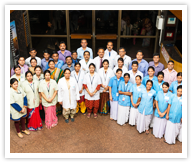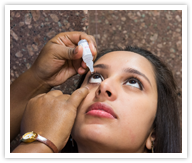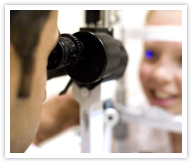
Helpline
8420008000
Donate Your Eyes
COVID-19 Protocol

- About Us
- Medical Services
- Hospital Facilities
- Patient Info
- Know your Eyes
- News & Events
- People
- Contact


- Home
- /
- Know your Eyes
- /
- Eyes through the years
Eyes through the years
Different vision problems arise at different ages. Like most organs the eye develops until adulthood and begins to age after 40.

- Your Vision in :
- Childhood
- Adulthood and Middle Age
- The Senior Years
Your Vision in Childhood
Childhood Vision Problems
- Problem: Eyes that cross or are not lined up with each other.
What it could be: Eyes that are not aligned (strabismus).
What to do about it: Take your child to a pediatric eye doctor. The doctor may patch the stronger eye to strengthen the weaker one, or prescribe special glasses or eye exercises. - Problem: Trouble seeing things that are far away.
What it could be: Nearsightedness, or myopia.
What to do about it: Eyeglasses or contact lenses can improve distance vision. - Problem: Trouble seeing things that are close up.
What it could be: Farsightedness, or hyperopia.
What to do about it: Eyeglasses or contact lenses can improve close-up vision. - Problem: Blurry vision.
What it could be: Astigmatism - a curved cornea that can't focus images clearly.
What to do about it: Wearing eyeglasses can improve your child's vision. - Problem: Blurry vision or has failed an eye screening.
What it could be: Lazy eye, or amblyopia, which occurs when an underlying cause prevents vision from developing properly in one eye.
What to do about it: Amblyopia often has no symptoms. That's why regular eye exams are critical. With early detection and treatment, vision can usually be corrected. Depending on the cause, treatment may include an eye patch on the stronger eye, eyeglasses, or rarely surgery. - Less common vision problems in kids include:
Glaucoma a group of diseases that can threaten vision by damaging the eye's main nerve; caused by a build-up of fluid that increases pressure inside the eye. Sometimes children are born with glaucoma; others develop it at a young age.
Cataract a clouding of the eye's lens that can be caused by diabetes and other childhood diseases, or by trauma to the eye. Some children are born with cataracts.
Retinoblastoma a rare cancer of the retina.
Look out for these signs that your child is struggling to see clearly:
- Complaining about headaches or blurry vision
- Closing one eye
- Rubbing the eyes
- Complaining about pain in the eye
- Redness, tearing, oozing, or crust in the eyes
- Having an eye that turns in, out, up, down, or wanders
- Eyes that cross or can't focus
- Trouble reading -- holding the book really close to see the words
When you spot one of these symptoms, make an appointment with your child's pediatrician or an eye doctor. Getting a check-up right away can let the doctor identify vision problems before they can affect your child's sight.
Your Vision in Adulthood and Middle Age
- Problem: At around age 40, you have to hold books and newspapers farther from your eyes to read them.
What it could be: Presbyopia, or the inability to focus up close.
Presbyopia is one of the most common vision problems in middle age. As you get older, the lens of your eye becomes less flexible than it was when you were young. A less flexible lens can't focus clearly.
What to do about it: Your doctor may recommend reading glasses, which come with and without a prescription. Bifocals, trifocals (progressive) contact lenses and corrective surgery may be prescribed. - Problem: The world looks blurry - both up close, and at a distance.
What it could be: Astigmatism.
An abnormally shaped cornea can't focus light clearly on the back of your eye, making everything look out of focus.
What to do about it: See your eye doctor. A pair of glasses or contact lenses can correct astigmatism. Laser surgery is a longer-term option that restores clear vision by reshaping your cornea. - Problem: Your eyes feel dry and irritated all the time.
What it could be: Dry eye syndrome.
As you get older, your eyes naturally produce fewer tears. Having laser eye surgery or wearing contact lenses can make the problem worse.
What to do about it: If you've got mild dry eye, artificial tears can bring back the moisture. For more severe dry eye, ask about prescription eye drops or a procedure that blocks your tear ducts to keep more of your own tears in your eyes. - Problem: Your eyesight changes from day to day.
What it could be: Rising and falling blood sugar levels.
With untreated diabetes, your need to wear glasses can change, depending on whether your blood sugar level is high or normal. Over a much longer period of time, uncontrolled high blood sugar from diabetes damages the delicate blood vessels in your eyes. These damaged vessels leak blood, which affects your vision.
What to do about it: See your doctor for a check-up. Managing high blood sugar can prevent diabetic retinopathy and vision loss. When blood vessel damage is severe, you may need surgery to seal the leaks. - Problem: You have a family history of glaucoma.
What it could be: Glaucoma.
Glaucoma is a group of eye diseases that can damage the optic nerve. The trouble is glaucoma often sets in without any symptoms. You may not realize that you have it until you've already lost vision.
What to do about it: Don't let glaucoma go. See your eye doctor for a regular eye pressure test before you develop any eye problems. Once your eye doctor catches glaucoma, drops and/or surgery can keep it from stealing your sight. - Problem: There's a film over everything you see.
What it could be: Cataracts.
This clouding of the eye's lens becomes more common as you get older, as protein inside your lens starts to clump together. Cataracts can also create a halo effect around lights at night, and make your eyes more sensitive to glare.
What to do about it: Until the cataract causes unacceptable vision problems, you can increase lighting and change your eyeglass prescription to help you see more clearly. Once the haze gets in your way, talk to your doctor about surgery to remove the clouded lens and replace it with a clear artificial one. - Problem: You've got a raging headache that started with distorted vision and flashes of light.
What it could be: Migraine headaches.
Migraines don't just make your head hurt. They also can affect your vision, creating a light show of auras and flashes. You can even briefly lose sight from certain types of migraines.
What to do about it: If this is a brand-new problem for you, call your doctor immediately. If you're diagnosed with migraines,learning what triggers your headaches - such as caffeine or stress - and then avoiding those triggers can make your headaches come less frequently. Several different medicines can help prevent a migraine or stop one in its tracks. If you lose vision with your migraines, call your eye doctor right away - it could be a sign of a more serious vision problem. - Problem: Spots and objects float through your vision.
What it could be: Floaters.
Floaters are tiny specs that hover around inside your eyes. They appear when the fluid inside your eye starts to break down with age.
What to do about it: If you are seeing new floaters all of a sudden, especially if they occur with flashes of light, see your eye doctor. Most of the time, floaters are an annoying, harmless issue. Sometimes, though, they can be a sign of a retinal tear, which can turn into a retinal detachment if you don't get it treated.Although they're a pain to live with, floaters are a normal part of getting older, and they won't harm your vision. But if the floaters suddenly start multiplying, and you're also seeing flashing lights, get to your eye doctor's office.
Your Vision in the Senior Years
- Problem: Inability to focus well on objects close up
What it could be: Presbyopia, caused by hardening of the lens and change of muscle tone within the eyes
What to do about it: An eye care professional can diagnose presbyopia and correct it with contact lenses or eyeglasses - Problem: There's a film over everything you see.
What it could be: Cataracts. Clouding of the eye's lens becomes more common as you get older, as protein inside your lens starts to clump together. Cataracts can also create a halo effect around lights at night, and make your eyes more sensitive to glare.
What to do about it: A small surgery can correct cataracts. - Problem: Floaters (appear as spots, threadlike strands, or squiggly lines that drift around)
What it could be: A gel-like substance known as vitreous fills up a large portion of your eye, forming its round shape. As you get older, this gel shrinks. Strands of vitreous can cast shadows on the retina, causing "floaters." This is usually a harmless, natural part of aging.
What to do about it: Although most floaters need no treatment, have your eye doctor assess flashes and floaters. - Problem: Dry eyes
What it could be: Sometimes eyes produce too few tears or tears of poor quality. This makes it hard for the eyes to stay healthy.
What to do about it: For mild dry eye, over-the-counter artificial tears may do the trick, along with self-care, such as increasing humidity. Prescription eye drops or other types of treatment may be best for more severe cases of dry eye.
Other eye changes from aging
- Pupils (the opening at the center of the eye's iris) decrease in size and are less able to dilate (open). This means less light reaches the retina.
- Corneas become less sensitive. This means you are less likely to notice any injuries. As with the lens, the aging cornea also becomes more prone to causing glare.
- Eyelids droop or may become inflamed. This sometimes affects vision.
- Peripheral vision and the ability to judge distances (depth perception) both worsen.
You can make some adjustments to deal with these changes, such as:
- Use extra lighting and avoid naked bulbs.
- Choose "high color" fluorescent bulbs with a color-rendering index of 80 or above.
- Wear glasses with anti-reflective coating.
- Eliminate distractions when driving.
What to do about it: Don't forget to have your eyes examined at least once a year. Early diagnosis can protect your eyes from more serious eye conditions that can worsen or become more likely with aging. Of course, the old standards still apply to good visual health: exercise regularly, don't smoke, and protect your eyes from ultraviolet rays and injury. Wear a wide-brimmed hat and sunglasses with 100% UVA and UVB protection.














